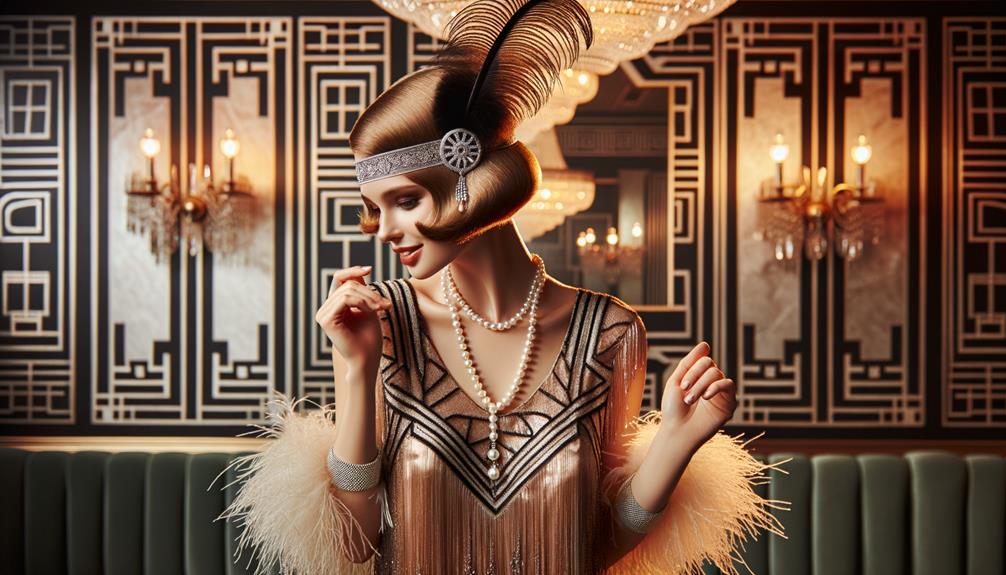I've watched hip-hop fashion evolve from its roots in Bronx block parties into a global trend. In the 1980s, Run-DMC's Adidas sneakers and Kangol hats signaled a cultural shift. By the 1990s, baggy jeans and brands like FUBU and Sean John defined the streetwear scene. The 2000s saw rap stars flaunt 'bling' and luxury collaborations, blurring the lines between street and high fashion. Today, Kanye's Yeezy merges athleisure and couture, while designers like Virgil Abloh infuse hip-hop elements into luxury brands. It's fascinating to see how this style has gone from the gritty streets to the runways of high fashion.
Origins of Hip-Hop Fashion
Hip-hop fashion grew out of the block parties in 1970s Bronx, becoming a canvas for self-expression through tracksuits and sneakers. The distinctive looks of pioneering figures like Kool Herc and Grandmaster Flash laid the foundation for what hip-hop fashion would become, beyond just the beats and rhymes.
Streetwear became a statement, a way for individuals to express their identity. Tracksuits and sneakers became synonymous with the early hip-hop vibe, capturing the essence of the streets. Harlem legend Dapper Dan revolutionized this scene by repurposing luxury fabrics into custom-made streetwear, bridging the gap to mainstream fashion.
Artists like Tupac Shakur and Aaliyah brought early hip-hop fashion to the forefront with their iconic styles in music videos. The culture was vibrant, innovative, and unapologetically stylish. It wasn't just fashion; it was a movement that spoke volumes about identity and self-expression.
Evolution in the 1980s
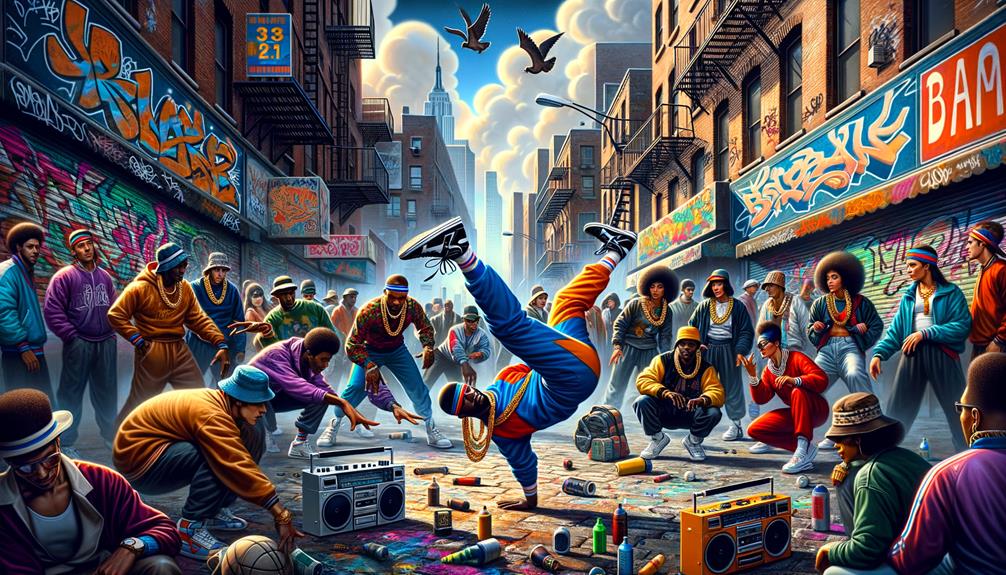
When I reflect on the 1980s, I can't help but see the rise of streetwear through the lens of iconic hip-hop artists like Run-DMC. Their signature looks, featuring denim, Kangol hats, and Adidas sneakers, became synonymous with the era. Dapper Dan's fusion of streetwear and high-end luxury brands also stands out, offering a unique blend that redefined fashion. This period was about more than just clothes – it was a powerful statement that echoed Afrocentrism and a deep connection to African heritage.
Birth of Streetwear
In the 1980s, the streets were abuzz with a new fashion language. The boldness of Adidas sneakers and the swagger of thick gold chains spoke volumes – this was the birth of hip-hop fashion. Run-DMC epitomized this trend with their iconic Adidas shoes and Kangol hats, capturing the spirit of youth culture.
Observing the rise of streetwear, I noticed how Dapper Dan revolutionized the scene by blending hip-hop fashion with luxury brands. He took the opulence of Gucci and Louis Vuitton and infused it into custom streetwear, creating a bridge between the streets and high fashion. This fusion wasn't just about looking good; it was about challenging norms and embracing individuality.
The birth of streetwear in the '80s was more than a trend; it was a cultural shift. It embodied a persona, an attitude that defied convention. As sportswear brands like Adidas capitalized on this movement, they cemented hip-hop fashion's place in the cultural zeitgeist. Streetwear wasn't just worn – it was a way of life.
Iconic Hip-Hop Influences
In the 1980s, icons like Run-DMC and Dapper Dan transformed streetwear into a cultural phenomenon. Run-DMC's Adidas sneakers and tracksuits weren't just about comfort; they were a statement of hip-hop fashion that resonated with a generation. Their raw, unapologetic look was instantly recognizable, embodying the spirit of early hip-hop.
Dapper Dan, a Harlem legend, went further by blending streetwear with luxury brands. His custom pieces for hip-hop artists redefined fashion, creating a unique mix of opulence and street credibility. These designs weren't just clothes; they were symbols of defiance and ingenuity.
Afrocentric fashion surged, showcasing bold patterns, bright colors, and heavy jewelry. This wasn't just about aesthetics; it was a powerful expression of cultural pride. Thick gold chains, inspired by African tribal history, became emblematic of status and identity within the community.
Fashion for early hip-hop artists was a form of rebellion and self-expression. It allowed them to carve out their personal style and challenge societal norms, making hip-hop fashion a cornerstone of cultural transformation.
Trends of the 1990s
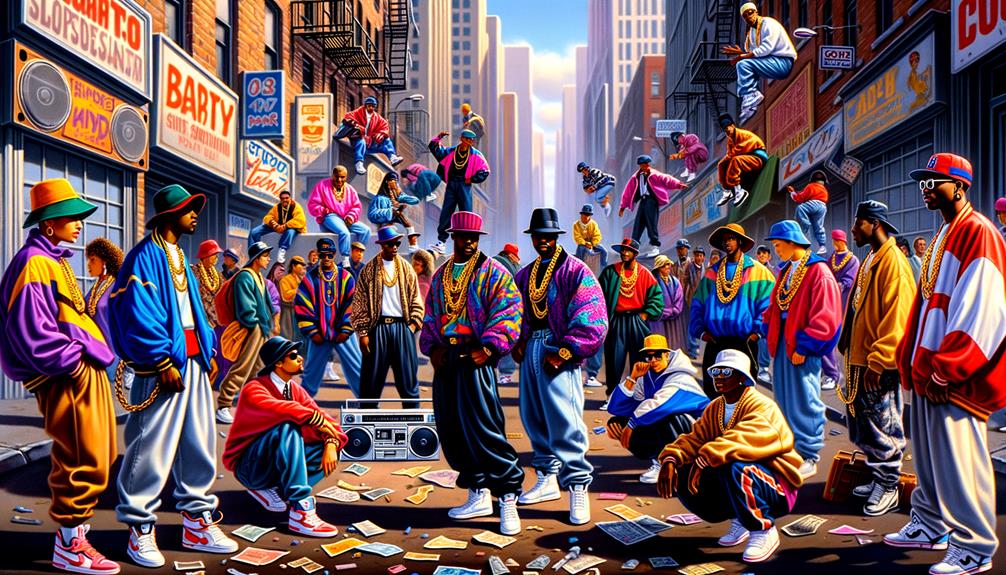
In the 1990s, oversized clothing like baggy jeans and extra-large hoodies became a hallmark of hip-hop fashion. Walking the streets or watching music videos, it was hard to miss the bold style statements. Brands like Tommy Hilfiger, FUBU, Phat Farm, and Sean John became synonymous with the hip-hop lifestyle, offering looks that resonated deeply with the culture.
The 90s hip-hop aesthetic was raw and unapologetic, mirroring the gritty beats and powerful lyrics of the music. Fashion was about making a statement – snapback hats, Timberland boots, and chunky gold chains were essential accessories, adding personality and swagger to the outfits.
These streetwear brands catered to the growing demand for urban-inspired fashion. Artists like TLC, Aaliyah, and Ja Rule showcased the trends in their music videos, making them accessible and aspirational. Hip-hop style became a bridge between the streets and mainstream fashion, setting the stage for the evolution that would follow in the next decade.
The 2000s Influence
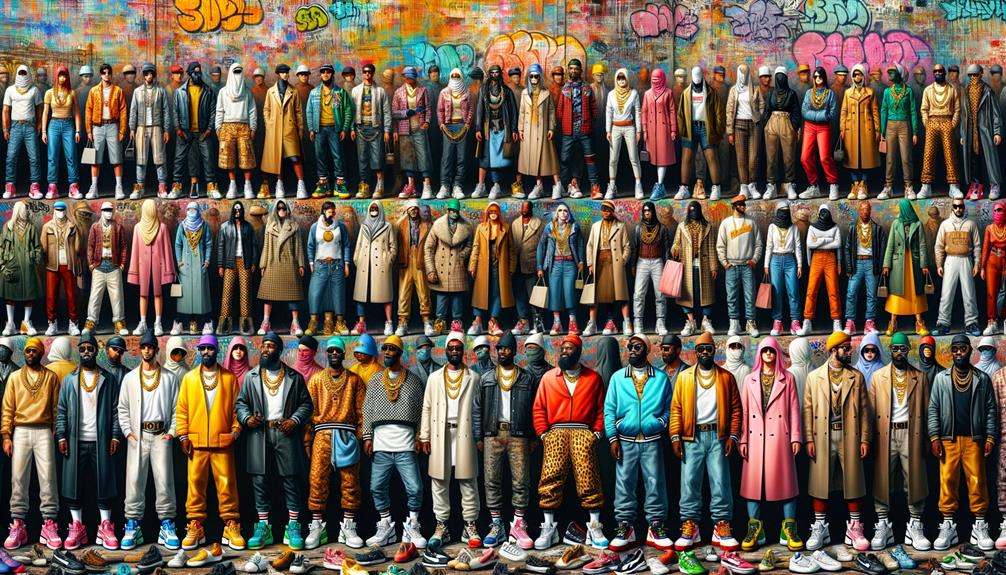
In the 2000s, I couldn't help but notice how hip-hop fashion took center stage. Rappers were rocking bold 'bling' and baggy jeans, and they weren't just influencing style – they were creating it through designer collaborations that brought streetwear into the luxury market. It's fascinating how artists like Jay-Z and Kanye West blurred the lines between urban culture and high fashion, shaping the way we think about fashion and self-expression.
Bling and Baggy Jeans
The 2000s were a defining era in hip-hop fashion, marked by the ubiquitous presence of bling and baggy jeans. Bling, in the form of extravagant, diamond-encrusted jewelry, became a symbol of wealth and success, with artists like Lil' Kim, Nelly, and Ja Rule leading the charge with their ostentatious displays of chains, rings, and grills.
Simultaneously, baggy denim pants emerged as the signature look of the hip-hop scene. These weren't your average jeans – they were low-rise, wide-legged statements of rebellion, often paired with wife-beater tanks and bandanas. The resulting look was a blend of ruggedness and defiance, a rejection of conformity.
Brands like Sean John, Rocawear, and Fubu capitalized on this fashion trend, merging urban streetwear with a touch of luxury. Their designs were more than just clothing; they were cultural milestones, embraced by both hip-hop artists and their fans. The mainstream crossover was undeniable, as the look that originated on the streets found its way into suburban malls and department stores, making hip-hop fashion a universal language of style and nonconformity.
The 2000s were a transformative period, where fashion was not merely about what you wore, but about making a bold statement.
Designer Collaborations Emerge
As hip-hop fashion gained prominence in the 2000s, with trends like bling and baggy jeans, the industry underwent a fascinating evolution. Luxury fashion brands began to intersect with the raw, authentic vibe of hip-hop, creating collaborative collections that reshaped the landscape.
Sean 'Diddy' Combs was an early pioneer, as his label Sean John merged upscale aesthetics with streetwear, making a substantial impact. Rapper-led brands like Nelly's Vokal and Jay-Z's Rocawear not only appealed to hip-hop consumers but also influenced mainstream fashion, showcasing the cultural clout of the genre.
However, it was the collaborations between high fashion and hip-hop icons that truly revolutionized the scene. Kanye West's Yeezy line for Adidas exemplifies this, seamlessly blending streetwear with high fashion sensibilities. Partnerships like Gucci's with Harlem designer Dapper Dan allowed fashion houses to incorporate genuine hip-hop elements into their collections.
This fusion paved the way for designers like Virgil Abloh, whose work epitomizes the bridge between streetwear and luxury fashion. These collaborations didn't just merge two worlds; they redefined them, proving that innovation often lies at the crossroads of culture and couture.
Modern Hip-Hop Style
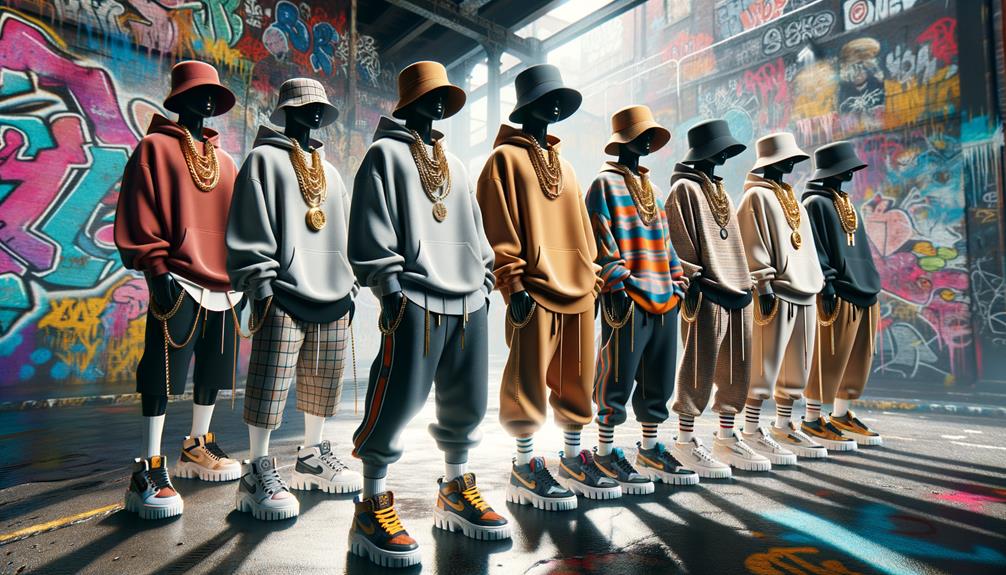
Modern hip-hop style is a vibrant blend of streetwear and high fashion, with its oversized silhouettes and bold graphics. The evolution of hip-hop fashion has become a powerful statement of individuality and cultural expression. The fusion of streetwear and luxury fashion is evident in the rise of athleisure, where brands like Adidas collaborate with icons such as Kanye West. His Yeezy line epitomizes this blend, pushing boundaries and redefining what's fashionable.
Celebrities like Rihanna and Travis Scott have also played significant roles in shaping modern hip-hop style. Their influence extends beyond music, permeating into fashion and setting trends that resonate globally. Social media amplifies their impact, making hip-hop inspired looks accessible to millions. Platforms like Instagram and TikTok are filled with influencers showcasing their interpretations, further blurring the lines between streetwear and luxury fashion.
Inclusivity and diversity are now at the forefront, reflecting the rich, multifaceted culture of hip-hop. The industry's embrace of these values ensures that everyone sees themselves represented. Modern hip-hop fashion isn't just about clothing; it's a dynamic, evolving narrative that champions innovation and self-expression.
Impact on High Fashion
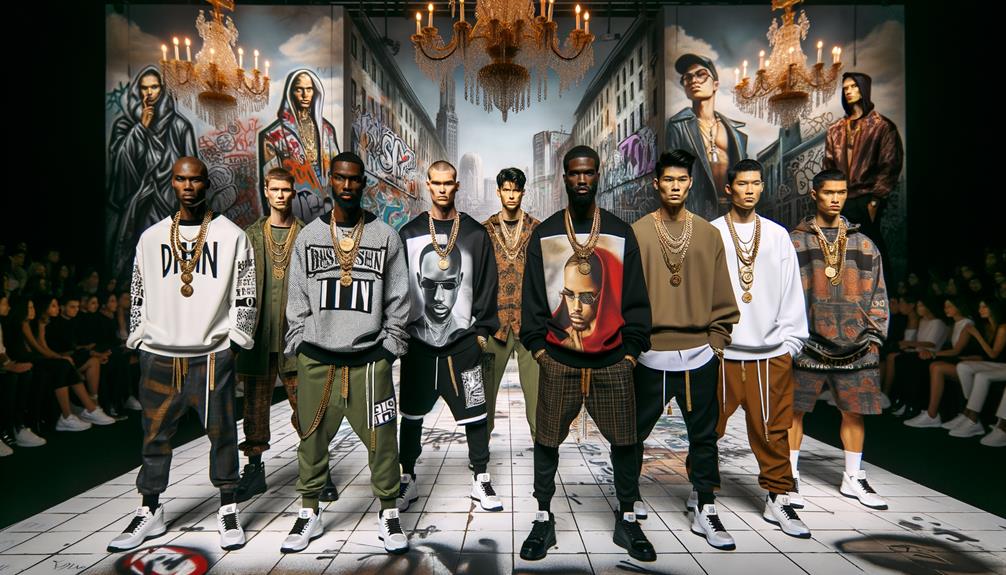
The seamless blend of streetwear and high fashion in modern hip-hop style has dramatically influenced luxury brands, pushing them to embrace the genre's bold aesthetics and cultural significance. Seeing Virgil Abloh at Louis Vuitton and Dapper Dan collaborating with Gucci makes it clear: hip-hop fashion has crossed over into the domain of high fashion, making an indelible impact on the runway.
Luxury brands now tap into the urban streetwear vibe, transforming classic silhouettes with a contemporary edge. For instance, Marc Jacobs integrates hip-hop elements, drawing from his New York upbringing. These influences have reshaped runway presentations, infusing them with a raw, authentic energy that's impossible to ignore.
| Designer | Influence |
|---|---|
| Virgil Abloh | Streetwear at Louis Vuitton |
| Dapper Dan | Urban aesthetics with Gucci |
| Marc Jacobs | NY hip-hop scene inspirations |
| Balmain | Hip-hop artist collaborations |
| Saint Laurent | Streetwear elements in luxury |
The adoption of baggy pants and 90s athleticwear on European and American runways further solidifies hip-hop's grip on high fashion. It's an ongoing dialogue between the streets and luxury brands, a fusion that's redefining what's considered high-end. As this transformation unfolds, it's evident that hip-hop is not just a trend; it's a cultural movement reshaping fashion's future.
Frequently Asked Questions
How Did Hip-Hop Influence Streetwear?
Hip-hop has profoundly impacted streetwear fashion. The genre's blend of practicality and bold self-expression has redefined traditional fashion norms. Oversized fits and the integration of luxury brands have become streetwear staples, transforming everyday wear into iconic, innovative statements. Street culture's creativity has imbued these garments with a unique sense of style and identity, making them so much more than just clothes. The intersection of hip-hop and streetwear has revolutionized the way we perceive and express ourselves through fashion.
What Caused the Rise of Hip-Hop?
The rise of hip-hop was fueled by the needs of urban youth seeking self-expression amidst economic and social challenges. Affordable audio equipment and the creativity of pioneering artists sparked a movement that transformed culture and inspired innovation. Hip-hop evolved from the Bronx in New York City, where block parties and DJs like Kool Herc laid the foundations. As affordable turntables and audio mixers became available, young people used these tools to create a new style of music that gave voice to their experiences and struggles. Influential figures like Afrika Bambaataa, Grandmaster Flash, and Run-DMC emerged, pioneering techniques like scratching and sampling that became integral to the genre. Hip-hop's raw energy, innovative production, and socially conscious lyrics resonated with marginalized communities, propelling it to become a global cultural phenomenon that continues to shape music, art, fashion, and more.
When Did Hip Hop Fashion Become Popular?
Hip hop fashion really became popular in the 1980s, thanks to iconic groups like Run-DMC. Their unique street-inspired style made waves, quickly spreading beyond the Bronx and shaping mainstream fashion. The look was bold and unapologetic, reflecting the energy of the emerging hip hop scene. Soon, oversized shirts, chain necklaces, and sneakers became a recognizable part of the cultural landscape, influencing how people dressed across the country. This fashion revolution was more than just trends – it was a way for communities to express their identity and pride through what they wore. The impact of 80s hip hop style is still felt today, as elements of that signature look continue to appear in contemporary fashion.
How Did the Style of Hip-Hop Develop?
Hip-hop fashion emerged organically from the block parties of the Bronx, evolving through various influences. The streetwear style of Run-DMC, the high-fashion fusion of Dapper Dan, the afrocentrism movement, and the rise of sportswear brands all played a role in shaping the unique visual identity of hip-hop culture. This sartorial journey transformed hip-hop from a local phenomenon into a mainstream cultural force, reflecting the dynamism and creativity of the genre.
Conclusion
From the gritty streets to the gleaming runways, hip-hop fashion has carved a remarkable journey. What was once a symbol of rebellion now graces the highest echelons of high fashion. The juxtaposition of baggy jeans and tailored suits is striking, yet it feels natural – a testament to hip-hop's profound cultural influence, blending audacity with elegance.
This fusion is a powerful dialogue between the past and the present, reminding us that true style transcends boundaries. It's a vibrant tapestry that celebrates the dynamism of a community, where self-expression and creativity converge to shape the sartorial landscape.
As we observe this evolution, we're reminded that fashion is not merely a surface-level pursuit, but a canvas for storytelling, a medium through which marginalized voices can assert their presence and reshape perceptions. The rise of hip-hop fashion is not just a trend, but a cultural revolution, one that continues to redefine the boundaries of what is considered fashionable and who gets to dictate it.



